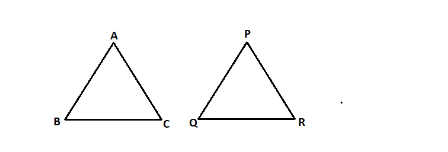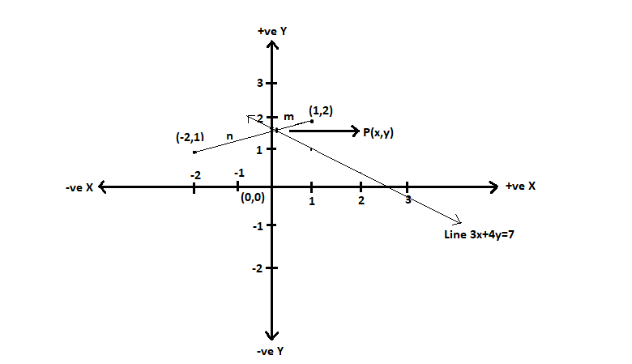Answer
405.3k+ views
Hint: If two triangles are similar, then the ratio of the areas of both the triangles is equal to the ratio of the squares of their corresponding sides. Here the ratio of the sides of the triangles is given. Using this, we are finding the ratio of their areas.
2. Let the point at which the line $ 3x + 4y = 7 $ touches the line segment joining the points $ \left( {1,2} \right) $ and $ \left( { - 2,1} \right) $ is $ P\left( {x,y} \right) $ and divides the line segment in the ratio $ m:n $ , then the coordinates of P can be found by $ x = \dfrac{{m{x_2} + n{x_1}}}{{m + n}},y = \dfrac{{m{y_2} + n{y_1}}}{{m + n}} $ , where $ \left( {{x_1},{y_1}} \right),\left( {{x_2},{y_2}} \right) $ are the given points. The point $ P\left( {x,y} \right) $ lies on the line $ 3x + 4y = 7 $ . So substitute its coordinates in the place of x and y of $ 3x + 4y = 7 $ to find the ratio of m and n.
Complete step-by-step answer:
1. We are given that the triangle ABC is similar to the triangle PQR.

And the ratio of sides $ \dfrac{{BC}}{{QR}} = \dfrac{1}{3} $ .
Then the ratio of areas of triangles ABC and PQR will be $ \dfrac{{Ar\left( {\Delta PQR} \right)}}{{Ar\left( {\Delta ABC} \right)}} = \dfrac{{Ar\left( {\Delta PRQ} \right)}}{{Ar\left( {\Delta BCA} \right)}} = {\left( {\dfrac{{QR}}{{BC}}} \right)^2} $
We already know that $ \dfrac{{BC}}{{QR}} = \dfrac{1}{3} $ , this gives $ \dfrac{{QR}}{{BC}} = \dfrac{3}{1} $
Therefore,
$ \dfrac{{Ar\left( {\Delta PRQ} \right)}}{{Ar\left( {\Delta BCA} \right)}} = {\left( {\dfrac{3}{1}} \right)^2} = \dfrac{9}{1} = 9 $
So, the correct answer is “ OPTION A”.
2. We are given that line $ 3x + 4y = 7 $ divides the line segment joining the points $ \left( {1,2} \right) $ and $ \left( { - 2,1} \right) $ . Let the line divide the line segment at point $ P\left( {x,y} \right) $ in a ratio $ m:n $ .

Then the coordinates of point $ P\left( {x,y} \right) $ will be $ \left( {\dfrac{{m{x_2} + n{x_1}}}{{m + n}},\dfrac{{m{y_2} + n{y_1}}}{{m + n}}} \right) $ , where $ \left( {{x_1},{y_1}} \right),\left( {{x_2},{y_2}} \right) $ are the given points and $ \left( {{x_1},{y_1}} \right) = \left( {1,2} \right),\left( {{x_2},{y_2}} \right) = \left( { - 2,1} \right) $ , and as we can see the point $ P\left( {x,y} \right) $ lies on the line $ 3x + 4y = 7 $
So we are substituting $ \left( {\dfrac{{m{x_2} + n{x_1}}}{{m + n}},\dfrac{{m{y_2} + n{y_1}}}{{m + n}}} \right) $ in the place of x and y of $ 3x + 4y = 7 $
$ 3\left( {\dfrac{{m{x_2} + n{x_1}}}{{m + n}}} \right) + 4\left( {\dfrac{{m{y_2} + n{y_1}}}{{m + n}}} \right) = 7 $
$ \Rightarrow 3m{x_2} + 3n{x_1} + 4m{y_2} + 4n{y_1} = 7\left( {m + n} \right) $
$ {x_1} = 1,{y_1} = 2,{x_2} = - 2,{y_2} = 1 $
$ \Rightarrow 3m\left( { - 2} \right) + 3n\left( 1 \right) + 4m\left( 1 \right) + 4n\left( 2 \right) = 7m + 7n $
$ \Rightarrow - 6m + 3n + 4m + 8n = 7m + 7n $
$ \Rightarrow - 2m + 11n = 7m + 7n $
$ \Rightarrow 11n - 7n = 7m + 2m $
$ \Rightarrow 4n = 9m $
$ \Rightarrow \dfrac{4}{9} = \dfrac{m}{n} $
$ \Rightarrow m:n = 4:9 $
Therefore, the line $ 3x + 4y = 7 $ divides the line segment joining the points $ \left( {1,2} \right) $ and $ \left( { - 2,1} \right) $ in the ratio 4:9.
So, the correct answer is “ 4:9”.
Note: Do not confuse similar triangles with congruent triangles, because congruent triangles have similar three sides and angles which mean similar areas, whereas the areas may or may not be the same in similar triangles. Congruent triangles are always similar whereas similar triangles may not be congruent always. A line can divide another line both internally and externally. When a line divides a line segment AB internally it produces a division point between A and B whereas when externally it produces a division point outside AB.
2. Let the point at which the line $ 3x + 4y = 7 $ touches the line segment joining the points $ \left( {1,2} \right) $ and $ \left( { - 2,1} \right) $ is $ P\left( {x,y} \right) $ and divides the line segment in the ratio $ m:n $ , then the coordinates of P can be found by $ x = \dfrac{{m{x_2} + n{x_1}}}{{m + n}},y = \dfrac{{m{y_2} + n{y_1}}}{{m + n}} $ , where $ \left( {{x_1},{y_1}} \right),\left( {{x_2},{y_2}} \right) $ are the given points. The point $ P\left( {x,y} \right) $ lies on the line $ 3x + 4y = 7 $ . So substitute its coordinates in the place of x and y of $ 3x + 4y = 7 $ to find the ratio of m and n.
Complete step-by-step answer:
1. We are given that the triangle ABC is similar to the triangle PQR.

And the ratio of sides $ \dfrac{{BC}}{{QR}} = \dfrac{1}{3} $ .
Then the ratio of areas of triangles ABC and PQR will be $ \dfrac{{Ar\left( {\Delta PQR} \right)}}{{Ar\left( {\Delta ABC} \right)}} = \dfrac{{Ar\left( {\Delta PRQ} \right)}}{{Ar\left( {\Delta BCA} \right)}} = {\left( {\dfrac{{QR}}{{BC}}} \right)^2} $
We already know that $ \dfrac{{BC}}{{QR}} = \dfrac{1}{3} $ , this gives $ \dfrac{{QR}}{{BC}} = \dfrac{3}{1} $
Therefore,
$ \dfrac{{Ar\left( {\Delta PRQ} \right)}}{{Ar\left( {\Delta BCA} \right)}} = {\left( {\dfrac{3}{1}} \right)^2} = \dfrac{9}{1} = 9 $
So, the correct answer is “ OPTION A”.
2. We are given that line $ 3x + 4y = 7 $ divides the line segment joining the points $ \left( {1,2} \right) $ and $ \left( { - 2,1} \right) $ . Let the line divide the line segment at point $ P\left( {x,y} \right) $ in a ratio $ m:n $ .

Then the coordinates of point $ P\left( {x,y} \right) $ will be $ \left( {\dfrac{{m{x_2} + n{x_1}}}{{m + n}},\dfrac{{m{y_2} + n{y_1}}}{{m + n}}} \right) $ , where $ \left( {{x_1},{y_1}} \right),\left( {{x_2},{y_2}} \right) $ are the given points and $ \left( {{x_1},{y_1}} \right) = \left( {1,2} \right),\left( {{x_2},{y_2}} \right) = \left( { - 2,1} \right) $ , and as we can see the point $ P\left( {x,y} \right) $ lies on the line $ 3x + 4y = 7 $
So we are substituting $ \left( {\dfrac{{m{x_2} + n{x_1}}}{{m + n}},\dfrac{{m{y_2} + n{y_1}}}{{m + n}}} \right) $ in the place of x and y of $ 3x + 4y = 7 $
$ 3\left( {\dfrac{{m{x_2} + n{x_1}}}{{m + n}}} \right) + 4\left( {\dfrac{{m{y_2} + n{y_1}}}{{m + n}}} \right) = 7 $
$ \Rightarrow 3m{x_2} + 3n{x_1} + 4m{y_2} + 4n{y_1} = 7\left( {m + n} \right) $
$ {x_1} = 1,{y_1} = 2,{x_2} = - 2,{y_2} = 1 $
$ \Rightarrow 3m\left( { - 2} \right) + 3n\left( 1 \right) + 4m\left( 1 \right) + 4n\left( 2 \right) = 7m + 7n $
$ \Rightarrow - 6m + 3n + 4m + 8n = 7m + 7n $
$ \Rightarrow - 2m + 11n = 7m + 7n $
$ \Rightarrow 11n - 7n = 7m + 2m $
$ \Rightarrow 4n = 9m $
$ \Rightarrow \dfrac{4}{9} = \dfrac{m}{n} $
$ \Rightarrow m:n = 4:9 $
Therefore, the line $ 3x + 4y = 7 $ divides the line segment joining the points $ \left( {1,2} \right) $ and $ \left( { - 2,1} \right) $ in the ratio 4:9.
So, the correct answer is “ 4:9”.
Note: Do not confuse similar triangles with congruent triangles, because congruent triangles have similar three sides and angles which mean similar areas, whereas the areas may or may not be the same in similar triangles. Congruent triangles are always similar whereas similar triangles may not be congruent always. A line can divide another line both internally and externally. When a line divides a line segment AB internally it produces a division point between A and B whereas when externally it produces a division point outside AB.
Recently Updated Pages
How many sigma and pi bonds are present in HCequiv class 11 chemistry CBSE

Why Are Noble Gases NonReactive class 11 chemistry CBSE

Let X and Y be the sets of all positive divisors of class 11 maths CBSE

Let x and y be 2 real numbers which satisfy the equations class 11 maths CBSE

Let x 4log 2sqrt 9k 1 + 7 and y dfrac132log 2sqrt5 class 11 maths CBSE

Let x22ax+b20 and x22bx+a20 be two equations Then the class 11 maths CBSE

Trending doubts
Fill the blanks with the suitable prepositions 1 The class 9 english CBSE

At which age domestication of animals started A Neolithic class 11 social science CBSE

Which are the Top 10 Largest Countries of the World?

Give 10 examples for herbs , shrubs , climbers , creepers

Difference between Prokaryotic cell and Eukaryotic class 11 biology CBSE

Difference Between Plant Cell and Animal Cell

Write a letter to the principal requesting him to grant class 10 english CBSE

Change the following sentences into negative and interrogative class 10 english CBSE

Fill in the blanks A 1 lakh ten thousand B 1 million class 9 maths CBSE



